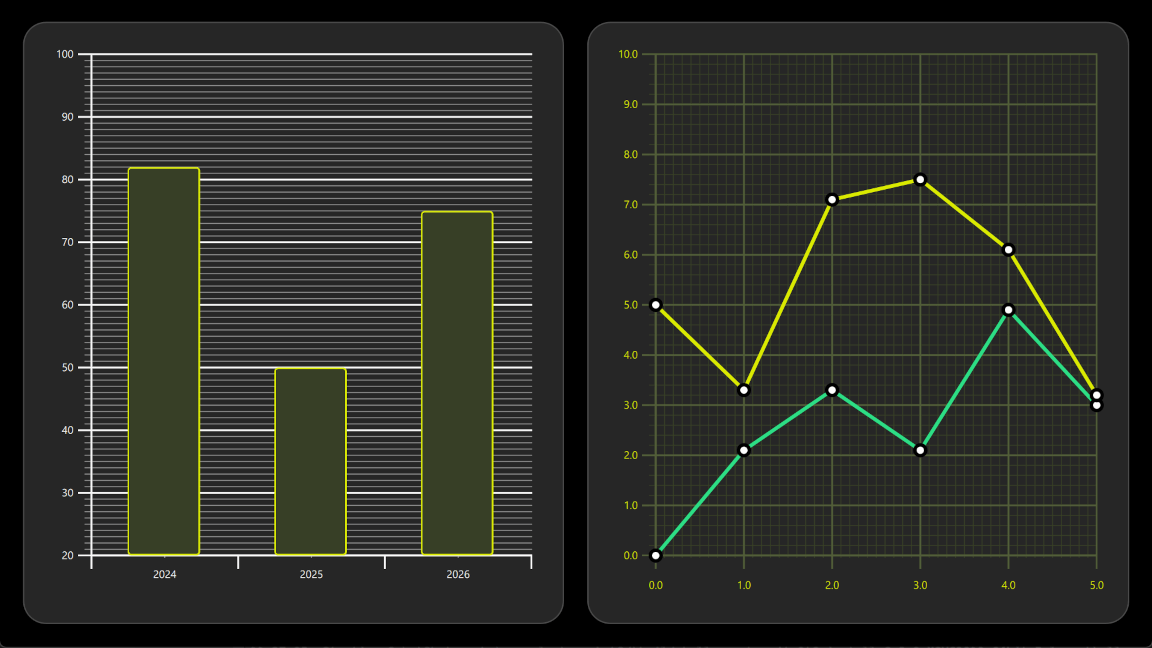Using Graphs for 2D in a Qt Quick application.
HelloGraphs shows how to make a simple 2D bar graph and line graph.

The following sections describe how to create a bar graph using BarSeries and a line graph using LineSeries .
要运行范例从 Qt Creator ,打开 欢迎 模式,然后选择范例从 范例 。更多信息,拜访 构建和运行范例 .
The first graph in the example is a bar graph. Creating it starts with a GraphsView component and setting the theme to one which is suitable on dark backgrounds. This theme adjusts the graph background grid and axis lines and labels.
GraphsView { anchors.fill: parent anchors.margins: 16 theme: GraphTheme { colorTheme: GraphTheme.ColorThemeDark } ...
To make this a bar graph, add a
BarSeries
. X axis of the series is
BarCategoryAxis
with 3 categories. We hide both the vertical grid and the axis lines. Y axis of the series is
ValueAxis
with visible range between 20 and 100. Major ticks with labels will be shown on every 10 values using
tickInterval
. Minor ticks will be shown on every 1 values using
minorTickCount
9
, which means that between every major ticks there will be
9
minor ones.
BarSeries { axisX: BarCategoryAxis { categories: [2024, 2025, 2026] gridVisible: false minorGridVisible: false } axisY: ValueAxis { min: 20 max: 100 tickInterval: 10 minorTickCount: 9 } ...
Then data is added into BarSeries 使用 BarSet . There are 3 bars, and we define custom bars color and border properties. These properties will override the possible theme set for the AbstractSeries .
BarSet { values: [82, 50, 75] borderWidth: 2 color: "#373F26" borderColor: "#DBEB00" }
The second graph of the example is a line graph. It also starts by defining a GraphsView element. Custom GraphTheme is created to get a custom appearance. GraphTheme offers quite a wide range of customization possibilities for the background grid and axis, which get applied after the colorTheme .
GraphsView { anchors.fill: parent anchors.margins: 16 theme: GraphTheme { readonly property color c1: "#DBEB00" readonly property color c2: "#373F26" readonly property color c3: Qt.lighter(c2, 1.5) colorTheme: GraphTheme.ColorThemeDark gridMajorBarsColor: c3 gridMinorBarsColor: c2 axisXMajorColor: c3 axisYMajorColor: c3 axisXMinorColor: c2 axisYMinorColor: c2 axisXLabelsColor: c1 axisYLabelsColor: c1 } ...
自定义
Marker
component is used to visualize the data points.
component Marker : Rectangle { width: 16 height: 16 color: "#ffffff" radius: width * 0.5 border.width: 4 border.color: "#000000" }
The previous bar graph didn't define a separate SeriesTheme , so it uses the default theme. This line graph uses a custom theme with the desired line colors.
SeriesTheme { id: seriesTheme colors: ["#2CDE85", "#DBEB00"] }
To make this a line graph, add a
LineSeries
. The first series defines
axisX
and
axisY
for this graph. It also sets the
pointMarker
to use the custom
Marker
component that was created earlier. Data points are added using
XYPoint
元素。
LineSeries { id: lineSeries1 theme: seriesTheme axisX: ValueAxis { max: 5 tickInterval: 1 minorTickCount: 9 labelDecimals: 1 } axisY: ValueAxis { max: 10 tickInterval: 1 minorTickCount: 4 labelDecimals: 1 } width: 4 pointMarker: Marker { } XYPoint { x: 0; y: 0 } XYPoint { x: 1; y: 2.1 } XYPoint { x: 2; y: 3.3 } XYPoint { x: 3; y: 2.1 } XYPoint { x: 4; y: 4.9 } XYPoint { x: 5; y: 3.0 } }
The second line series is similar to the first. The
axisX
and
axisY
don't need to be defined as the graph already contains them. As this is second
LineSeries
在
GraphsView
, second color from the
seriesTheme
gets automatically picked.
LineSeries { id: lineSeries2 theme: seriesTheme width: 4 pointMarker: Marker { } XYPoint { x: 0; y: 5.0 } XYPoint { x: 1; y: 3.3 } XYPoint { x: 2; y: 7.1 } XYPoint { x: 3; y: 7.5 } XYPoint { x: 4; y: 6.1 } XYPoint { x: 5; y: 3.2 } }